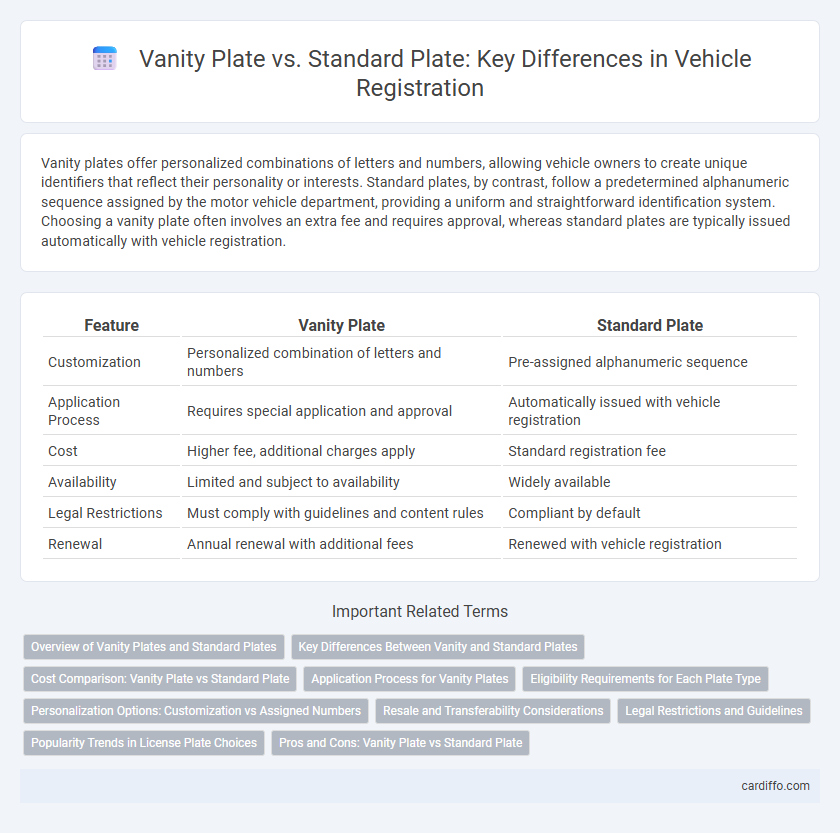Vanity plates offer personalized combinations of letters and numbers, allowing vehicle owners to create unique identifiers that reflect their personality or interests. Standard plates, by contrast, follow a predetermined alphanumeric sequence assigned by the motor vehicle department, providing a uniform and straightforward identification system. Choosing a vanity plate often involves an extra fee and requires approval, whereas standard plates are typically issued automatically with vehicle registration.
Table of Comparison
| Feature | Vanity Plate | Standard Plate |
|---|---|---|
| Customization | Personalized combination of letters and numbers | Pre-assigned alphanumeric sequence |
| Application Process | Requires special application and approval | Automatically issued with vehicle registration |
| Cost | Higher fee, additional charges apply | Standard registration fee |
| Availability | Limited and subject to availability | Widely available |
| Legal Restrictions | Must comply with guidelines and content rules | Compliant by default |
| Renewal | Annual renewal with additional fees | Renewed with vehicle registration |
Overview of Vanity Plates and Standard Plates
Vanity plates allow vehicle owners to customize their license plates with unique combinations of letters, numbers, or symbols, providing a personalized touch for an additional fee. Standard plates feature pre-issued alphanumeric sequences assigned by the vehicle registration authority, ensuring uniformity and easy identification. Both options adhere to state-specific regulations and are valid for legal vehicle operation.
Key Differences Between Vanity and Standard Plates
Vanity plates allow vehicle owners to customize their license characters, offering personalized combinations that reflect names, phrases, or special meanings, while standard plates follow a predefined alphanumeric format assigned by the DMV. Vanity plates typically incur higher fees and require approval for appropriateness, contrasting with the automatic issuance of standard plates. Both types serve as legal vehicle identifiers but differ significantly in personalization, cost, and issuance process.
Cost Comparison: Vanity Plate vs Standard Plate
Vanity plates typically cost between $40 to $100 more than standard plates, with fees varying by state. Standard plates usually have a base fee around $20 to $50, whereas vanity plates incur additional charges for personalization rights. Renewal fees for vanity plates can also be higher, reflecting the premium paid for customization options.
Application Process for Vanity Plates
Applying for vanity plates requires submitting a specialized application through the Department of Motor Vehicles (DMV) or equivalent authority, often including a list of preferred custom alphanumeric combinations. The process involves a thorough review to ensure the requested plate does not contain prohibited or offensive content and meets character length restrictions, typically ranging from 6 to 8 characters depending on jurisdiction. Applicants must pay an additional fee beyond the standard registration cost, with processing times that can extend from several weeks to months compared to the immediate issuance of standard plates.
Eligibility Requirements for Each Plate Type
Vanity plates require applicants to submit a personalized combination of letters and numbers that must be approved to avoid offensive or restricted content, with eligibility often limited to current vehicle owners in the state. Standard plates are issued automatically upon registration and typically follow a predefined alphanumeric sequence without customization options, requiring only proof of vehicle ownership and residency. Both plate types generally demand valid vehicle registration, insurance, and payment of associated fees, but vanity plates often incur additional costs and stricter approval guidelines.
Personalization Options: Customization vs Assigned Numbers
Vanity plates offer extensive personalization options, allowing vehicle owners to choose specific letter and number combinations that reflect their identity or interests. Standard plates, by contrast, are assigned randomly or sequentially by the registration authority, limiting customization but simplifying identification and record-keeping. The choice between vanity and standard plates balances personal expression against administrative efficiency and cost.
Resale and Transferability Considerations
Vanity plates often have limited resale value compared to standard plates, as their appeal depends on personal preference and specific character combinations. Standard plates generally offer higher transferability and broader market demand, making them easier to sell or transfer during vehicle resale. When considering registration, evaluating the potential impact on resale value and transferability is crucial for both vanity and standard license plates.
Legal Restrictions and Guidelines
Vanity plates must comply with specific legal restrictions, including prohibitions on offensive language, hate speech, and trademark infringement, which are more strictly enforced than on standard plates. Standard plates follow uniform state guidelines without customization, ensuring easier approval and fewer legal complications. Both types require adherence to size, font, and color regulations to maintain visibility and identification standards mandated by transportation authorities.
Popularity Trends in License Plate Choices
Vanity plates have surged in popularity, with over 30% of new registrants opting for personalized messages or unique alphanumeric combinations to express individuality. Standard plates remain widely used, accounting for approximately 65% of registrations due to their affordability and ease of issuance. Recent industry data indicates a growing preference for vanity plates in urban areas, driven by a desire for customization and digital integration options.
Pros and Cons: Vanity Plate vs Standard Plate
Vanity plates allow personalized license plates with unique combinations, offering vehicles a distinctive identity and potential style enhancement, but they often come with higher fees and longer processing times. Standard plates provide a cost-effective and readily available option with guaranteed legibility and compliance but lack personalization and may be less memorable. Choosing between vanity and standard plates depends on the balance between personal expression and budget constraints.
Vanity plate vs Standard plate Infographic

 cardiffo.com
cardiffo.com